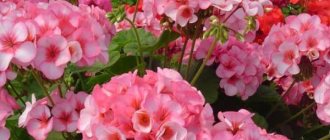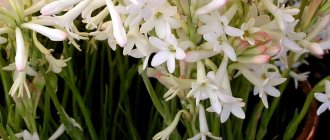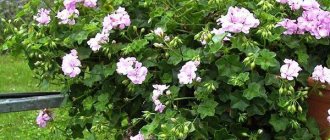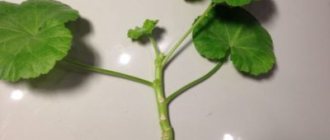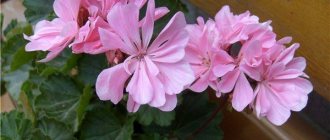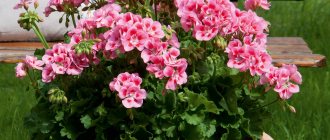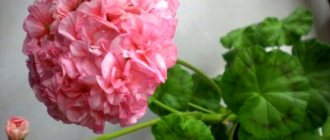We know geranium as an unpretentious indoor plant that delights with bright, numerous flowers from spring until winter. However, not everyone knows that there is another type of this flower that grows quietly in open ground. The hardy “sister” can be found in the garden, forest or marshy area. Botanists have divided them into two varieties, one of which is called “geranium” and the other “pelargonium”. It was the second that became the favorite of almost all gardeners. Both genera belong to the same Geranium family and have the same origin.
Features of winter and summer care for home geraniums
Geranium looks different in winter and summer. This is due to the length of the day and the need to give the plant a rest before the next flowering period.
In summer, protect pelargoniums from direct sunlight. In winter, choose the most illuminated window sill. If the apartment does not have south windows, use a phytolamp, extending the daylight hours to 12-14 hours. This way, the bush will retain its shape, the shoots will not lengthen, and the leaves will not fade.
The room temperature should be at least 22 degrees in summer and no more than 16 degrees in winter. Warmth will help pelargonium bloom magnificently in summer, and coolness in winter will allow you to get the necessary rest and gain strength.
By the way, pelargoniums tolerate ventilation well (not to be confused with drafts!), but not the dry heat of radiators.
In summer, during the flowering period, the plant should be watered more abundantly. In winter, when the geranium is dormant, watering should be moderate. This will prevent excessive soil moisture, which can cause root rot.
What to do with geraniums grown outside in autumn and winter?
Autumn can be very cold, especially in the pre-winter months, so don't risk leaving your geraniums outside. Plants can tolerate cold weather, but only to a certain extent. It is dangerous to expose pelargonium to night frosts and negative temperatures. It may freeze, which will lead to irreversible consequences.
In order to preserve the plants in time and lay the foundation for future flowering, they must be sent for the winter. To do this, you need to put the pelargonium on the balcony, porch, cellar, warm garage or basement. If it grows in a pot, there will be no problems with carrying it. And when grown in open ground, geranium must be carefully transplanted into a pot with a root ball and left for the winter in an unheated room.
Wintering geraniums
Geranium pruning
This procedure can be carried out in autumn or spring, depending on the variety of pelargonium. Zonal pelargoniums, for example, can grow greatly, and if this does not bother you in any way, they do not need to be pruned. In this case, small plants should be left without pruning until spring. For variegated varieties, pruning is very stressful, so it is recommended to do it in the spring. Ampelous pelargoniums need to be pruned only if they grow excessively.
Important: Always remove faded inflorescences and yellowed leaves, regardless of the type of geranium, and pruning is an individual procedure for almost each variety. For small pelargoniums, pruning will not matter much, but for large plants it is very important.
Procedure for pruning pelargoniums in autumn
At the end of September, cut off absolutely all flowering shoots, regardless of whether they have bloomed or are still active. This will help the geranium preserve its resources for the winter.
Leaves that have already turned yellow and wilted or are just beginning to turn yellow are removed. Experienced gardeners recommend pinching them off rather than cutting them with scissors. In the latter case, only a few protruding roots remain.
For denser flowering in September, pelargonium should be pruned before the branches begin or just above the node (from 3 to 5 cm). Then the top cut shoots can be rooted as cuttings. You need to continue pruning the plant until it loses its beautiful, lush appearance.
If the plant is young, it should only be pinched, and this must be done in accordance with the following rules :
- Start pinching young plants after they reach a height of 5-6 cm.
- When the geranium grows another 5 cm, it should be pinched again.
- To get a spherical bush, you can trim it three times in the same way.
Where and how to plant?
This type of geranium is recommended to be planted from January to April. Planting should begin with sowing seeds. It is better to do this in January-February. Soil for sowing geranium seeds can be purchased at any specialty store. It is also possible to make a soil mixture yourself using peat, turf soil and river sand.
- To plant seeds, grooves of not great depth are laid, which, after laying evenly, are lightly sprinkled. Under no circumstances should excess moisture be allowed in the soil. Otherwise, the roots of a “newborn” plant may simply rot.
- To maintain optimal humidity conditions, the crops need to be covered with film or glass, and then placed in a bright, but not hot place with a maximum temperature of 24 degrees.
- As soon as the cotyledons appear, the glass or film must be removed, the crops must be moved to a more illuminated place, and the temperature must be lowered to 18 degrees. If the seedlings do not have enough light, they will quickly stretch out and then simply die.
- The next stage is the appearance of two full-fledged leaves. Then the picking occurs in pots with a maximum diameter of 10 cm.
- If your plant is stretched out, the problem can be corrected by deepening the planting site by 2 cm.
- After 2 weeks, fertilizing with liquid organic fertilizers begins.
- And after the onset of May, in its second half, the plant is planted on the ground. If the planting area is not a flowerbed, but a balcony or veranda, then you can plant geraniums there already in early May.
Important. In order for geranium to survive the winter, with the onset of cold weather, the flower must be covered.
Lighting and location
"Black Velvet" differs from all other varieties of geranium in that it prefers exclusively well-lit areas .
It should be taken into account that direct exposure to sunlight should not last the entire daylight hours.
It is best if the sun shines brightly in the first half of the day, and then the flower is in the shade.
Soil requirements
The plant is planted at a depth of 2-3 cm greater than when planting seeds. In terms of soil, “Black Velvet” is unpretentious. Any type of land will suit him. However, it is necessary to monitor watering and dryness of the planting site. In addition, at the end of the season, river sand (coarse) should be added to improve the permeability of the soil.
The flower has a positive attitude towards mineral fertilizers, so if you wish, you can fertilize the soil at least once a season.
Let's summarize - the most important thing in caring for geraniums
Proper care is the key to growth and lush flowering. “Green friends” tolerate ventilation well, but cold drafts are dangerous for them. It is important to follow all recommendations during the first time after planting.
- The soil. To plant cuttings, use a mixture of sand and universal soil in a ratio of 1 to 2.
- A weak solution of potassium permanganate will disinfect the prepared soil from harmful microorganisms, parasites, and pests. Potassium permanganate solution can be replaced with boiling water. In this case, you must wait until the substrate cools down.
- If cuttings take root in water, you can add activated carbon to the water. This will reduce the chance of rotting.
- Lush bushes can be obtained by timely pruning. You can do this any time of the year.
- For the normal development of pelargonium in the room, it is necessary to maintain the temperature at +20 degrees Celsius.
- If the leaves begin to dry out during rooting, cover the container with the cuttings with polyethylene, film or a lid.
- It is more convenient to plant seedlings using plastic cups. A drainage layer must be laid at the bottom. In addition, drainage holes must be made.
- A lack of light will quickly lead to a loss of lushness, and the bushes will become stunted. The location of pelargonium should be reconsidered. In summer, pots or flowerpots should be placed on the balcony. Bright light gives the leaves a reddish tint, which is not a sign of disease, it's just a "tan."
- Watering should be moderate and systematic. Spraying is not necessary. The main rule is to not allow the soil to dry out. Signs of this are yellowing of the leaves and their falling off. Avoid stagnation of water (do not allow the root system and neck to rot). Good drainage can help with this. In winter, watering is carried out less frequently. It is enough to water pelargonium 2-3 times every 4 weeks.
- The following fertilizers are suitable for geranium: phosphorus, nitrogen, potassium. With the right ratio of elements, your green pet will bloom profusely. You can use special fertilizers and complexes for this type of flowering plants.
- Pruning is a prerequisite for the proper development of pelargonium. The best time for this procedure is autumn. It promotes the formation of an elegant crown and greater tillering.
Description of appearance and photo
Black geranium is the only one of all varieties that is distinguished by its dark chocolate leaves. Plant height is 25-30 cm. The leaves are dark brown in the center, green at the edges, with a slight wave . Moreover, the leaves of black geranium in the first year of life have a bronze tint, and only as they grow they become chocolate. The inflorescences of this geranium are small and can be pink, light pink, and sometimes bright red.
This variety is a multifloral, i.e. it is quite compact, low, and has abundant flowering. At the beginning of the 20th century, geranium was popularly called the “poor man's rose.”
See photos of this unusual and beautiful plant:
Common diseases and pests
Despite the apparent unpretentiousness and endurance, geraniums, including the “Black Velvet” variety, are subject to various kinds of diseases . The most common are:
- Rust due to fungal infection. Symptoms include rusty spots on the leaves.
- Botrytis mushroom. Because of it, dead zones in the form of concentric circles may appear on the sheet. If the plant is not treated, the leaves may begin to fall, followed by rotting.
Viral infections. The symptoms of the disease are very extensive: from changes in the color of leaves and stems to a complete stop of growth.- Edema. In the presence of this disease, chlorotic areas appear. If no action is taken, the plant will lose its foliage and then die completely.
All diseases can be prevented by proper care: you need to water the geranium on time, monitor the amount of moisture and temperature, and also carefully examine your pet.
Pests that can cause serious damage to plant health include:
- Nematodes. The most serious opponent. It is not possible to get rid of this pest. If Black Velvet is affected by them, then there is nothing left to do but get rid of the flower and the soil in which it was grown.
- Spider mite.
- Aphid.
- Whitefly.
It is possible to combat the last three types of pests with the help of specialized products, which are presented in a huge assortment in hardware stores.
Features of reproduction
Black geranium can be propagated in several ways. The most common are:
- Cuttings. To do this, cut off the shoot at the top so that 2-3 healthy leaves remain. The resulting cuttings are planted in the ground to a depth of 2-3 centimeters at a temperature of 15 degrees. For the first five days, you need to keep the seedlings in the dark, then put them in a shaded place.
- Propagation by seeds. After Black Velvet has produced seeds, they need to be carefully collected. Next, the seeds are lightly rubbed with sandpaper. This is done in order to speed up germination. After sowing, the planting is covered and placed in a dark place.
- Root division. Only mature plants are suitable for this method. The bush is dug out of the ground, then the shoots are cut off with a sterile instrument. The container in which new plants are planted should be small - no more than 10 centimeters in diameter.
Geranium is an incredibly beautiful plant. How to choose which flower to plant in the garden or on the windowsill from all the variety of plant species and varieties? We have prepared a number of articles in which you can read about the unpretentious Roberta, about the interesting Plenum geranium, about hybrids of the Angel variety, about the perennial Peony, you will learn what is good about Max Fry, how to care for the fragrant and aromatic Lemon, how to grow blooming Rosanna all summer long and rosebud.
“Black Velvet” is an amazingly beautiful and unusual flower that will delight you with long and abundant flowering, thanking the owner for his attention and care.
Description of pelargonium
Pelargonium Zonale belongs to the Geraniaceae family and the genus Geranium, which has 400 different representatives. Visually, these species bear little resemblance to indoor plants. Therefore, it is not entirely correct to call zonal pelargonium geranium from a scientific point of view, but in the everyday sense such a term can be used.
The color of pelargonium flowers can be very different.
Origin
The plant's homeland is Africa, and pelargonium was brought to Europe only in the 17th century. These flowers began to be grown in Holland. Today, thanks to serious breeding work, a variety of varieties have been developed.
Pelargoniums began to appear in botanical gardens in different countries and in private collections. Due to constant breeding, the original characteristics of the plant were lost, but in the end it was possible to obtain specimens with unusual leaf colors and aesthetic flowering.
Today, zonal pelargonium (geranium) is very popular among gardeners from all over the world.
Important! In warm countries it is planted in flower beds, where it blooms beautifully and attracts attention. It is also grown as a houseplant.
Not everyone knows the history of the origin of the name “zonal pelargonium” and what it means. It's all about the unusual color of the leaves - they have a pronounced dark “rim”. It can be brown, purple, dark green, chocolate, burgundy.
There is one classification and it is based on the division by height. Mini geraniums do not exceed 13 cm in length, dwarf geraniums - 20 cm, medium geraniums - 60 cm, tall ones - 80 cm.
The color of the “rim” on the leaves also varies.
It is best to divide pelargoniums by variety, but in this case you need to carefully study the description of each species.


